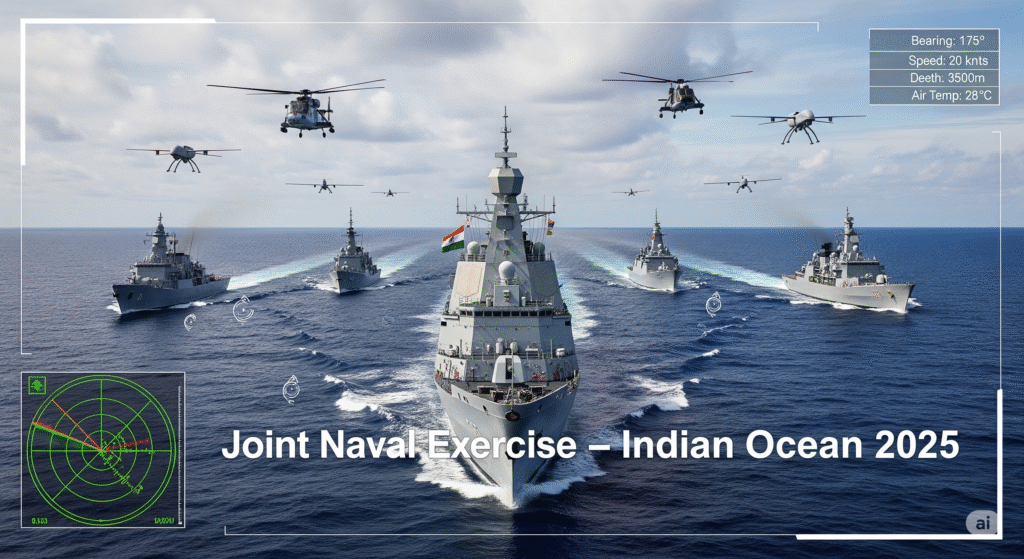Cochin Shipyard Delivers ASW-SWC ‘Mahe’: Shallow Waters No Longer Safe for Adversaries
On October 23, 2025, the Indian Navy took a decisive step toward maritime self-reliance. At Cochin Shipyard Limited (CSL), the lead vessel of the Anti-Submarine Warfare Shallow Water Craft (ASW-SWC) project — INS Mahe — was formally commissioned in a ceremony attended by senior naval brass and defence industry leaders.
Named after the historic port city in Puducherry, this 78-meter, 1,500-tonne corvette is not just a ship — it is a statement. With 80% indigenous content, advanced sonar suites, lightweight torpedoes, and Diesel-Waterjet propulsion, Mahe transforms India’s ability to dominate littoral waters where larger warships dare not tread.
Design and Technological Edge
Designed under DNV classification by CSL’s in-house team, Mahe represents a leap in brown-water naval capability. Its compact size and shallow draft (under 3 meters) allow operations in depths as low as 50 meters — perfect for coastal patrols, riverine ops, and chokepoint denial in the Andaman and Nicobar Islands.
Key systems include:
- Hull-mounted sonar: Detects submerged threats up to 15 km
- Variable Depth Sonar (VDS): Layered acoustic coverage in noisy shallows
- Varunastra torpedoes: Indigenous heavyweight anti-submarine weapon
- Anti-submarine rockets: Rapid response against close-in threats
- 30mm CRN-91 guns: Surface engagement and CIWS role
Stealth features — low radar cross-section, reduced acoustic signature, and IR suppression — make Mahe a ghost in contested waters. Its Diesel-Waterjet propulsion delivers 25 knots with superior maneuverability, outpacing conventional propeller-driven corvettes in tight spaces.
Operational Role in Littoral Dominance
Mahe fills a critical gap. Pakistan’s Hangor-class submarines and China’s Yuan-class diesel-electric boats increasingly probe India’s coastal waters. Traditional frigates and destroyers are too large for shallow zones — leaving EEZ patrols vulnerable.
Now, Mahe can:
- Hunt submarines in the Gulf of Mannar and Palk Bay
- Escort coastal convoys and offshore assets
- Lay mines in enemy approaches
- Support amphibious landings with fire support
In the Andamans, Mahe will pair with INS Vikrant’s carrier group to create a layered ASW screen — denying adversary submarines access to Malacca Strait chokepoints.
From Shipyard to Frontline: The Build Story
Launched in May 2024, Mahe is the first of eight ASW-SWCs under a ₹6,300 crore contract awarded to CSL and GRSE. The project achieved 20% faster construction through modular assembly — a first for Indian shipyards.
Crew: 57 (including 8 officers). Automation reduces manning by 30% compared to legacy Abhay-class corvettes. Endurance: 1,800 nautical miles at 15 knots — sufficient for week-long patrols without resupply.
The seventh hull, INS Magdala, was launched days before Mahe’s delivery — signaling production momentum. All eight vessels will be in service by 2027, replacing the aging Abhay-class and boosting India’s corvette fleet by 25%.
Strategic Impact on Coastal Security
Post-Operation Sindoor, hybrid threats — drone swarms, submarine-launched missiles, and sabotage — have escalated. Mahe’s mine-laying capability adds an offensive dimension, while its sonar grid integrates with P-8I Poseidon aircraft for networked ASW operations.
The ICG’s new Fast Patrol Vessels (Ajit and Aparajit) now have a naval counterpart in brown waters. Together, they form a seamless coastal defence umbrella from Gujarat to the Andamans.
Export Potential and Atmanirbhar Bharat
Mahe is not just for India. Southeast Asian nations — Vietnam, Philippines, Indonesia — face similar shallow-water submarine threats from China. With combat-proven systems and 80% indigenous content, Mahe is export-ready under the Defence Export Promotion Scheme.
CSL is already in talks with friendly navies for licensed production. The success of this project has validated India’s shipbuilding ecosystem — from steel to sensors — reducing import dependence from 60% in 2014 to under 20% today.
Challenges and Future Evolution
Submarine quieting technology remains a gap. DRDO is developing next-gen anechoic coatings for future batches. Integration with unmanned underwater vehicles (UUVs) for persistent ASW is planned by 2030.
The ASW-SWC fleet will evolve into a “system of systems” — linked via secure data links to satellites, P-8Is, and shore stations. The vision: a self-healing, AI-driven coastal defence network.



